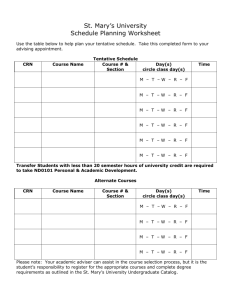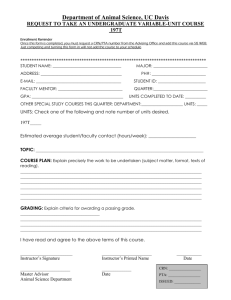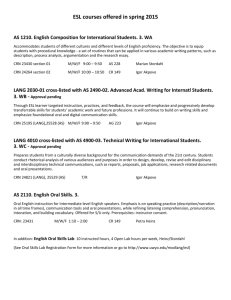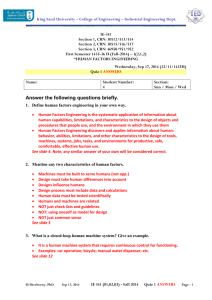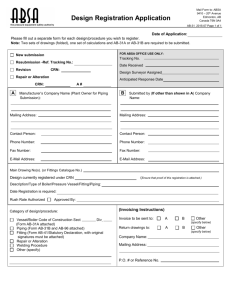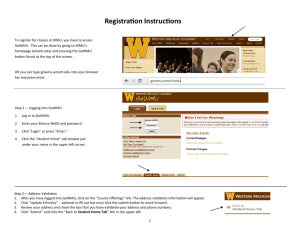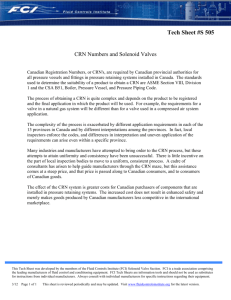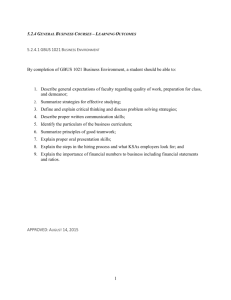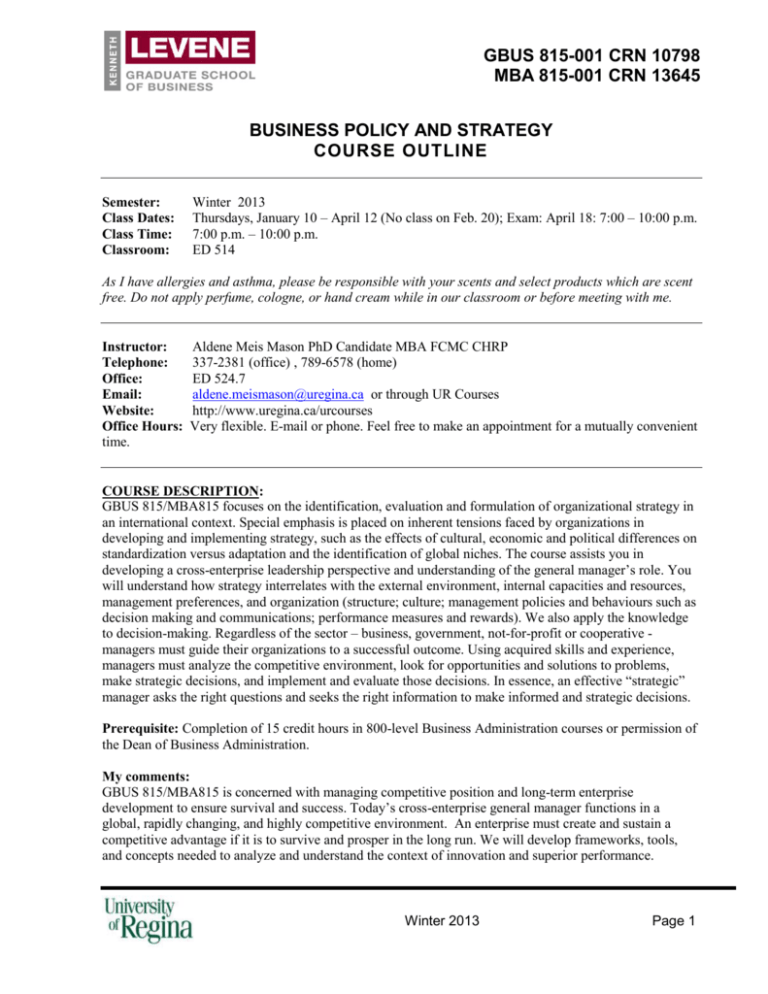
GBUS 815-001 CRN 10798
MBA 815-001 CRN 13645
BUSINESS POLICY AND STRATEGY
COURSE OUTLINE
Semester:
Class Dates:
Class Time:
Classroom:
Winter 2013
Thursdays, January 10 – April 12 (No class on Feb. 20); Exam: April 18: 7:00 – 10:00 p.m.
7:00 p.m. – 10:00 p.m.
ED 514
As I have allergies and asthma, please be responsible with your scents and select products which are scent
free. Do not apply perfume, cologne, or hand cream while in our classroom or before meeting with me.
Instructor:
Telephone:
Office:
Email:
Website:
Office Hours:
time.
Aldene Meis Mason PhD Candidate MBA FCMC CHRP
337-2381 (office) , 789-6578 (home)
ED 524.7
aldene.meismason@uregina.ca or through UR Courses
http://www.uregina.ca/urcourses
Very flexible. E-mail or phone. Feel free to make an appointment for a mutually convenient
COURSE DESCRIPTION:
GBUS 815/MBA815 focuses on the identification, evaluation and formulation of organizational strategy in
an international context. Special emphasis is placed on inherent tensions faced by organizations in
developing and implementing strategy, such as the effects of cultural, economic and political differences on
standardization versus adaptation and the identification of global niches. The course assists you in
developing a cross-enterprise leadership perspective and understanding of the general manager’s role. You
will understand how strategy interrelates with the external environment, internal capacities and resources,
management preferences, and organization (structure; culture; management policies and behaviours such as
decision making and communications; performance measures and rewards). We also apply the knowledge
to decision-making. Regardless of the sector – business, government, not-for-profit or cooperative managers must guide their organizations to a successful outcome. Using acquired skills and experience,
managers must analyze the competitive environment, look for opportunities and solutions to problems,
make strategic decisions, and implement and evaluate those decisions. In essence, an effective “strategic”
manager asks the right questions and seeks the right information to make informed and strategic decisions.
Prerequisite: Completion of 15 credit hours in 800-level Business Administration courses or permission of
the Dean of Business Administration.
My comments:
GBUS 815/MBA815 is concerned with managing competitive position and long-term enterprise
development to ensure survival and success. Today’s cross-enterprise general manager functions in a
global, rapidly changing, and highly competitive environment. An enterprise must create and sustain a
competitive advantage if it is to survive and prosper in the long run. We will develop frameworks, tools,
and concepts needed to analyze and understand the context of innovation and superior performance.
Winter 2013
Page 1
GBUS 815-001 CRN 10798
MBA 815-001 CRN 13645
Industries differ in the extent to which they provide opportunities for sustained performance. They are
dynamic and evolve over time, providing changing opportunities and threats. Enterprises compete for
position through their actions and interactions to innovate processes, products and services in order to
generate superior customer value. We spend the first part of our course exploring the challenges of external
environmental analysis to gain insight into what enterprises must do to succeed.
The second part of our course focuses on internal analysis, the drivers of success and what an enterprise can
do to succeed. Resource, capability, and organization analysis define the enterprise’s core competencies and
provide insight into its strengths and weaknesses as it relates to the external environment (opportunities and
threats). An understanding of an enterprise’s strengths enables the enterprise to more fully exploit and build
its capabilities to successfully compete. Finally, we bring our external and internal analyses together to
consider strategy formulation and implementation that can create and sustain competitive advantage.
Throughout the course, we also examine the role of the corporate governance.
LEARNING OBJECTIVES:
Strategic management provides you with the opportunity to integrate concepts, tools, and approaches from
previous business courses as well as from your experience in business and organizations. The strategic
management process reconciles the positioning stream, the resource-based view, the learning process
considerations, and the development of dynamic capability requirements. So, the emphasis will be put on
the organisation's competitive position building within the industry as well as on the acquisition,
maintenance, and development of resources and capability.
At the end of this course, you should be able to:
describe the roles of the general manager, owner and board of directors;
describe and measure the performance of an enterprise;
describe the process of successful strategic management;
analyse the competitive forces in an industry or an enterprise’s sector of activities;
assess current resources and capabilities of an enterprise;
diagnose the strategic posture of an enterprise;
communicate an appreciation of the synergies created by managing the interdependencies between
functional areas of an enterprise and across enterprises;
discuss the various ways an enterprise can improve its resources and build its sustainable
competitive advantages in the domestic and global marketplace;
formulate strategy for an enterprise at corporate, business, and functional levels;
implement a strategy, namely, by designing the appropriate organisation structure and processes,
and allocating necessary resources;
control the appropriateness of an implementation and evaluate results of a strategy.
Please visit the class website for a detailed description of competencies related to Business Policy and
Strategy. To accomplish these objectives, the course will use lectures, discussions, readings, case studies,
student analysis, experiential exercises, and guest speakers.
Winter 2013
Page 2
GBUS 815-001 CRN 10798
MBA 815-001 CRN 13645
RESOURCES:
Required Textbook and Course Materials:
1. Mary M. Crossan, Michael J. Rouse, Joseph N. Fry, & J. Peter Killing, Strategic Analysis & Action, 8th
Edition, Pearson Prentice Hall, 2013. Available in print or e-book.
2. Cases and required readings are provided through our UR Course website. Please review these in
advance of analyzing the assigned case. A fee per case or reading will be added to your class fees.
Some readings are also provided through our UR library links and Access Copyright License.
Supplementary Course Materials:
Several strategy textbooks are on reserve in the library. Students are encouraged to read academic and
professional journals such as the Harvard Business Review. Kate Cushon, our Business Librarian, has
developed a library resource guide for Business Policy and Strategy.
The following case writing resource materials will be put on reserve at the Archer Library:
a. Mauffette-Leenders, Louise A., James A. Erskine and Michael R. Leenders. Learning with Cases,
4th Edition. University of Western Ontario (Ivey Publishing): London, ON, 2005.
b. Mauffette-Leenders, Louise A., James A. Erskine and Michael R. Leenders. Writing Cases, 4th
Edition. The University of Western Ontario (Ivey Publishing), 2001. Links to other case writing
materials will be provided through UR Courses.
Other case writing resource materials available through the internet will be listed on our UR Courses
website.
REAL WORLD LEARNING COMMUNITY PARTNER:
The Town Nipawin/Twin Lakes District www.nipawin.com is our community partner and will provide real
world learning experiences for this semester. Information about the community and associated links are
provided on our website. Students who have not already committed themselves to case projects with their
employers will have an opportunity to partner with some enterprises/ organizations from Nipawin and the
Twin Lakes District. We will connect with our partners using the internet, skype, and phone. Students may
voluntarily choose to visit the Nipawin/Twin Lakes District.
CLASS SCHEDULE (SUMMARY) Note: Detailed preparation is located at the end of our course
outline and on our UR Courses website.
DATE
Jan. 10
Jan. 17
Jan. 24
CLASS TOPICS
READING
Cross-Enterprise Leadership, The General
Manager & Board, Strategic Management,
Measuring Firm Performance
Strategic Management & Diamond-E
Case Writing and Teaching Notes
Business Models
REQUIRED
Intro.,Ch.1,
Porter 2011
Prepare Case 1 (before class)
Ch. 2, 3 &
ppt.,
Chatterjee
2005
HBR Jan/11
& ppt
Prepare Case 2
Submit mark distribution
Winter 2013
Prepare Case 3
Page 3
GBUS 815-001 CRN 10798
MBA 815-001 CRN 13645
DATE
CLASS TOPICS
READING
Jan. 31
Strategy – Environment Linkage
Prepare & Submit Case 4
Feb. 7
Strategy – Resources & Capabilities Linkage
Ch. 4, 5 &
ppt.
Ch. 6 & ppt.
Feb. 14
Strategy – Management Preference Linkage
Dynamics of Family Business
No Class University Closed
Strategy and Organization
Corporate Level Strategy: Creating Value
through Diversification
Globalization & International Strategy
Ch.7, ppt
Reading
Prepare Case 6
Ch. 8, 9, ppt.
HBR Mar./11
Prepare Case 7
Prepare & Submit Case 8
HBR Sept/01
3 Readings
Ch. 10 &11
1 Reading
3 Readings
Prepare Case 9
Feb. 21
Feb. 28
Mar. 7
Mar. 14
Mar. 21
Mar. 28
Managing Strategic Choice, Personal Action,
Implementation & Risk Mitigation
Knowledge Management & Innovation
Apr. 4
Presentation of Term Projects
Apr. 11
Making Strategic Alliances/Partnerships Work
Wrap Up and Evaluation
FINAL EXAM – 7:00 p.m. (location tba)
Apr. 18
2 Readings
REQUIRED
Prepare Case 5
Case Proposal Due
Prepare Case 10
Prepare Case 11
Submit Case & Teaching
Note
Prepare Case 12
-
-
GRADING AND DELIVERABLES:
Mark Distribution:
To provide more flexibility in your course, you may choose to adjust the marking scheme, within the
minimum and maximum ranges, to a total of 100%. Please note that you can adjust them in five-mark
increments (e.g., no 13% or 22.5% marks; just 15% or 25%, etc.). If changing your distribution, please email your preference by 12:00 p.m. on January 24 (in week three). No changes will be made after that date.
The default and optional distributions are as follows:
Deliverable
As Per Outline
Minimum
Maximum
1. Two Case Write-ups (individual) – Due Jan. 31
and Mar. 7
2. Case Writing Proposal (small group) - Due by
Feb. 7
3. Case and Analysis (small group) - Due April 4
3. Class Participation
4. Final Case Exam (April 18: 7 PM - 10 PM)
TOTAL
20%
15%
30%
5%
5%
5%
25%
15%
35%
100%
20%
10%
30%
30%
15%
40%
Winter 2013
Page 4
GBUS 815-001 CRN 10798
MBA 815-001 CRN 13645
The grading is further detailed as follows:
1. Case Write-up:
Each learner will submit two written cases for assigned cases. Cases will be submitted on January
31 and March 7 by 12:00 p.m. Please note that no late assignments will be accepted.
The following format will be followed:
Introduction - Define issue(s) and problem, root causes/urgency/importance/ and a very brief
context to the situation (but avoid repeating case information).
Analysis: Add key points and your conclusion about the external environment. Also, include
key points and your conclusion about the internal environment, and the organization’s capacity
to take advantage of the situation.
Alternatives & Discussion: What are the distinct solutions to the addressing the problem?
These will be “what to do”, not “how to do it”. Discuss the alternatives using a matrix and
whatever decision criteria you choose.
Recommendation: What is the chosen alternative? Briefly state why selected.
Implementation and Action Plan: What are actions that could be taken? Use a table and be
sure to sequence into first 100 days, mid-, and long-term time frames. Identify who, what,
when, milestones, measurables and risks/contingencies.
Your write-up will be limited to 3 pages plus 2 pages of exhibits (single-spaced, 11-point font with
one-inch/2.5 cm. margins and use the preceding headings. The write-ups will be a Word document
attached to an e-mail or submitted through UR Courses. No paper copies will be submitted.
2. Term Project Case and Case Analysis:
The term project will consist of three parts. First, students will prepare a case proposal, share this
with the enterprise/organization and receive its written consent to do the case. The case proposal is
submitted as a hand in. Second, students will research and prepare a strategy case (in the style of
the in-class cases) on a current business / organization. Third, complete a case analysis on the same
written case, using the format in the preceding Case Write-up section. The report will be
submitted electronically in Word or Word-compatible format (no PDFs). The document will be 11point font, single-spaced, and have one-inch (2.5 cm.) margins. An approximate length for each of
the second and third parts will be 5-10 pages. Note: All cases must be accompanied by a signed
consent and case release from the company.
The term project is done in a group of 3 or 4 people. Experience suggests that group cases often
produce better results. Every group member must contribute fully or will have their mark reduced.
All groups will complete and submit a peer evaluation form.
Your selected topic, the name of the selected organization, and group members’ names must be
submitted in a summary by brief e-mail by February 7th.The purpose of the proposal is to get you
thinking earlier about the project and so that you can get some assistance of developing and
implementing your topic. The project will be discussed further in the first few weeks of class.
Please note that no late assignments will be accepted.
Winter 2013
Page 5
GBUS 815-001 CRN 10798
MBA 815-001 CRN 13645
3. Participation:
Learning in this class is not a one-way direction (i.e., from the Instructor to you). You and your
colleagues are also critical to the collective learning in class. Your colleagues’ experiences and
understandings will assist your learning, and you are expected to reciprocate by also being prepared
and participating. All learners will have considerable experience in the content elements of the
course and are expected to provide their experience / knowledge to benefit other learners.
You are expected to attend every class and to arrive to class prior to the start time. If you cannot
attend or expect to be late, please advise Aldene Meis Mason in advance. You cannot participate if
you are not in attendance. Thus, you will be marked on both participation and attendance. A
contribution consists of making observations, asking key questions, citing relevant examples,
offering an alternate viewpoint (even if you don’t share that view), and providing other leadership
in class. Participation marks will be distributed as follows:
Exceeds Expectations
8.0 -10.0 Provides leadership in (and out) of the classroom and works towards enhancing
interpersonal dynamics. Not dominating discussions but bringing others into the
discussion, acting as facilitators.
Meets Expectations
6.1-7.9 Shows an active interest in class activities and participates in classroom discussions; or
regularly makes insightful comments, which help others to understand the course
material; being a positive group member, etc.
Does not Meet Expectations
3.1-6.0 Attends class on a regular basis, and occasionally contributes to classroom experience.
0.0-3.0
Fails to contribute and does not have regular attendance.
4. Final Exam:
The final exam will be a comprehensive case and will be held April 18 from 7:00 – 10:00 p.m. The
location and details of the exam will be confirmed closer to the exam date.
HELPFUL INFORMATION
Special Needs:
If any learner who, because of a disability, needs accommodation(s), please contact the Centre for Student
Accessibility Office at 585-4631 (they will prepare the Accommodation Form). Discuss the Form with the
professor.
Writing Assistance:
The Student Success Centre (www.uregina.ca/ssc) and International Student Services offer both on-line
resources and in-person tutoring on writing skills.
Winter 2013
Page 6
GBUS 815-001 CRN 10798
MBA 815-001 CRN 13645
Citations:
If you use others’ work and ideas, you must cite your information properly. Plagiarism is a serious issue and
plagiarizing others’ work is considered misconduct under Section 5.13 Student Behaviour in the 2012-13
Academic Calendar. Please ask the Instructor if you are unsure whether your usage is an issue. For this
class, you must use the APA style of citations.
Students will have access to TURNITIN for submission of draft deliverables. Based on this feedback, you
may make corrections before submitting the final deliverable to the professor.
Policies
1. Respectful Learning, Working and Living Policies
The University of Regina promotes a learning, working and living environment which is respectful and free
of harassment and discrimination. Please discuss any concerns about conduct occurring in this class with
Aldene Meis Mason. Please refer to http://www.uregina.ca/hr/hdpo/understanding-and-recognizing and its
accompanying websites for more information.
2. Academic Integrity (Honesty, Cheating and Plagiarism)
High professional standards of ethics and integrity are important in today’s work places and at the
university. Please refer to the Faculty’s policy which will be distributed in class, discussed and posted on
our website. Cheating, plagiarism, and academic misconduct will be documented and handled according to
faculty and university policy. The library’s website provides information on sourcing and quoting ideas,
models, artwork, etc. Some examples of academic misconduct include:
Having another person represent you in class and/or in an exam.
Representing as your own work, work done in whole or in part by any other person, even if that
person is not in the course or is not a student at the University of Regina.
Allowing your computer account to be used by another person.
Using textbooks, course notes, past exams, personal computing devices, cell phones or any aids not
approved by the instructor during an examination.
Using material that you prepared for another class (self-plagiarizing)
Failing to take reasonable measures to protect your answers from use by other students on an
assignment or in an examination.
Stealing or destroying the work of another student.
Handing in work that was prepared for another course.
Most professional organizations such as accounting, finance, or human resources require members to
indicate annually whether they have been subject to penalty for ethical misconduct and if these matters have
been resolved.
3. Attendance
Attendance is monitored and in compliance with Faculty policy is reported to the Levene office. Failure to
attend classes affects not only performance but may result in not being allowed to write the examinations.
Winter 2013
Page 7
GBUS 815-001 CRN 10798
MBA 815-001 CRN 13645
CLASS SCHEDULE (DETAILED)
Week 1 – Jan. 10: Overview; The General Manager & Strategic Management
Key Objectives:
1. Understand strategic management process and how it is used.
2. Understand and apply role of General Manager and Board of Directors in strategy.
3. Know how to appraise current and past organizational performance.
4. Distinguish between vision, mission, values, and strategy and know how they are used.
Reading: Introduction, Chapter 1, and Reading: Measuring Firm Performance
Prepare Case 1: Veja: Sneakers with a Conscience
1. Is Veja more (or less) successful that other brands in the ethical products category?
2. In what ways does Veja’s business model differ from the conventional footwear models?
3. How did the founders build the brand? Was it the same process used by a typical business?
4. What are the strategic options and what would you recommend?
Assigned for class: Reflect on your experiences in management and be prepared to share your thoughts
Week 2 – Jan. 17: Strategic Management & Diamond-E/Case Writing & Teaching Notes
Key Objectives:
1. Differentiate between corporate and business strategy.
2. Identify firm’s strategy and know why that matters.
3. Use generic strategies: overall cost leadership, differentiation and focus to understand firm and
predict behaviour.
4. Apply core competencies and value proposition to make conclusions on firm’s capacity.
5. Use Diamond-E framework to understand influences on strategy.
6. Understand how to effectively analyze and discuss cases.
Reading: Chapters 2 & 3, Porter, Michael E. and Kramer, Mark R. Shared Value. Harvard Business
Review, Jan/Feb2011, Vol. 89 Issue 1/2, p62-77, 16p. Chatterjee , Syan. (Winter 2005) Core Objectives:
Clarity in Designing Strategy. California Management Review 47(2): 33-49.
Prepare Case 2: Shimla Dairy Products Private Limited, India: Poised for Growth?
Case Preparation:
1. Apply the Diamond-E framework.
2. Describe Shimla’s strategy, goals, value proposition, product market focus, and core activities.
3. What are the strategic options and what would you recommend and what actions would you take?
Case Writing and Analysis
Week 3 – Jan. 24: Business Models
Key Objectives:
1. Describe a business model.
2. Appreciate why some business models work while others fail.
3. Understand how selection of a business model fits within strategic management process.
4. Become aware of Next generation and bottom-of the pyramid models.
Reading: Casadeus-Masanell, Ramon; Joan E. Ricart. How to Design a Winning Business Model.
Harvard Business Review. January 1, 2011. Review powerpoint on website.
(continued)
Winter 2013
Page 8
GBUS 815-001 CRN 10798
MBA 815-001 CRN 13645
Prepare Case 3: Danimal in South Africa: Management Innovation at the Bottom of the Pyramid
1. What are the business models used by Danimal and how do they differ from other firms?
2. How would you measure the success of the project?
3. Using Gary Hamel's ideas on how business leaders can respond to the many "next generation"
challenges and opportunities outlined in his book, The Future of Management, how does the
approach taken by Maria Pretorius in managing the Danimal product line match up? (Use the
work on our website)
4. How does the project measure up to the Ten Principles of the United Nations Global Compact?
5. What are the strategic options and what would you recommend.
Assigned: E-mail submission of mark distribution alternative (optional).
Week 4 – Jan. 31: Strategy – Environment Linkage
Key Objectives:
1. Use environmental analysis tools (e.g., Porter’s Five Forces, PEST(R), Stakeholder, Game Theory
etc.) to assess external environment, nature of competition, and impact on the firm from
environmental changes.
2. Synthesize environmental information to understand implications for firm.
3. Make an overall conclusion on the industry’s attractiveness and on overall impact for the firm’s
strategic decisions.
4. Describe how to uses sources of information in the UR Library for scanning the company’s
environment
Reading: Chapters 4 & 5, review powerpoint on website.
Prepare and submit Case 4: TBA
1. How is the company performing?
1. What is its strategy?
2. Apply environment and industry analysis tools such as Porter’s Five Forces + Complementors,
PEST(R), Stakeholder, Game Theory, Blue Ocean, etc to determine challenges and opportunities
the company is facing within its environment?
3. How does the environment affect the other linkages?
4. What alternatives are available and how would you compare these?
2. What actions would you recommend?
Week 5 – Feb. 7: Strategy – Resources & Capabilities Linkage
Key Objectives:
1. Use internal analysis tools (e.g.,Value Chain, WOTS, CRACK, VRIO, etc.) to assess the firm’s
internal resources, capabilities, and competencies.
2. Understand stock vs dynamic capabilities.
3. Describe the four criteria necessary for sustainable competitive advantage
4. Synthesize internal analysis information to understand implications for firm.
5. Make an overall conclusion as to whether the firm can leverage its resources and competencies to
create a competitive advantage
Reading: Chapter 6 and review powerpoint on website.
Prepare Case 5: Hong Kong's Ocean Park Taking On Disney
1. What is your assessment of the Ocean Park’s performance and strategy?
2. What is the Ocean Park’s business model and how does the model add value?
3. What are Ocean Park’s dynamic capabilities and competencies? Describe the value chain.
4. What are the strategic options and what would you recommend?
Winter 2013
Page 9
GBUS 815-001 CRN 10798
MBA 815-001 CRN 13645
Week 6 – Strategy – Management Preference Linkage
Key Objectives:
1. Revisit the roles of the General Manager and the Board.
2. Explain in whose interest management is acting.
3. Describe factors to consider in understanding management’s preferences. How do the firm’s
incentives and culture impact these?
4. Illustrate how management preferences can influence strategy.
5. Develop an action plan for management to close the gaps between observed and required
management preferences.
6. Explain the dynamics of running a family business
Reading: Chapter 7, pp 191-194 & Reading on Family Business on website
Prepare Case 6: Rogers Chocolates (A)
1. How is the Roger's Chocolates performing?
2. What is its strategy?
3. Assess its environment?
4. What resources and capabilities are strong? Weak?
5. How are management preferences affecting strategic choice and execution?
6. What alternatives are available and how would you compare these?
7. As Steve Parkhill, what actions would you take?
Feb. 21 – No Class: Holiday
Week 7 – Feb. 28: Strategy and Organization
Key Objectives:
1. Explain organizational capabilities, behaviour, culture, structure, processes, and systems.
2. Discuss the required organizational capabilities (new goals, new value proposition, new
product/market focus, new core activities, resource gaps, preference gaps).
3. Describe how to develop the new organizational capabilities (organization structures, leadership
behaviour and management processes – decision making; operational; performance
assessment/reward).
4. Discuss the feasibility of changes (nature and magnitude of the change, time available, probability
the required capability will occur, overall feasibility and risk).
5. Explain the dynamics of strategic choice over time.
7. Explain the dynamics of running a family business
Readings: Ch. 8, 9, McKinsey 7S, ppt.
Prepare Case 7: Victoria Heavy Equipment Limited (2008)
1. The President’s job is open and it pays $400,000, would you accept the role?
2. What are the qualifications needed and what should be done in the job?
3. What are the elements of strategy and organization that must be addressed?
4. How does having family members impact of the business.
5. What are the strategic options and what would you recommend
(continued)
Winter 2013
Page 10
GBUS 815-001 CRN 10798
MBA 815-001 CRN 13645
Week 8 – Mar. 7: Corporate Level Strategy: Diversification and Acquisition
Key Objectives:
1. Understand why firms pursue diversification and recognize advantages and disadvantages.
2. Differentiate between types of diversification (e.g., unrelated, etc.).
3. Explain motives for acquisition and explain differences between types of acquisitions.
4. Describe stages in acquisition process.
Readings: Christensen, Clayton M.; Richard Alton; Curtis Rising; Andrew Waldeck. The New M&A
Playbook. Harvard Business Review. March 1, 2011.
Prepare and submit Case 8: Tavazo Co.
1. How did the Tavazo brothers decide on the list of potential countries in which to expand? Which
variables were most important in their decision making? What other useful variables might they
use?
2. Given the limited resources available to Tavazo, which expansion strategy would you recommend
to use their resources to expand vertically or to diversify geographically?
5. What challenges will Tavazo face in its expansion process as a family business?
Week 9 – Mar. 14: Globalization & International Strategy
Key Objectives:
1. Describe implications of international competition and globalization on strategy.
2. Outline implications of international context on Diamond E framework.
3. Examine strategies for choosing, entering and exploiting business opportunities in other countries.
4. Describe different organizational structures and management systems appropriate to the pursuit of
international strategies
Reading: 1) Ghemawat, Pankaj. Distance Still Matters: The Hard Reality of Global Expansion. Harvard
Business Review. September 1, pp. 137-146, 2001. 2) S. Tamer Cavusgilm, Tunga Kiyak and Sengun
Yeniyurt. 2004. Complementary approaches to preliminary foreign market entry assessment: Country
clustering and country ranking. Industrial Marketing Management 33, pp. 607-617. Link
http://www.sciencedirect.com/science/article/pii/S0019850103001512 3) Gregory E. Oslund, Charles R.
Taylor, Shaoming Zou. Selecting international modes of entry and expansion. Marketing Intelligence and
Planning. 19 (3), 153-161. Link
http://libproxy.uregina.ca:2048/login?url=http://dx.doi.org/10.1108/02634500110391690
Prepare Case 9: GENICON: A Surgical Strike into Emerging Markets
1. Evaluate the four countries’ market potential using comparable metrics. What country should be
selected on a purely quantitative basis and why?
2. Evaluate the four countries’ market potential using non-numeric information (e.g., ease of doing
business, culture, etc.). What country should be selected on that basis?
3. What are your decision criteria?
4. What country do you recommend?
5. Evaluate the options for entering the country. Which approach would you recommend?
6. Describe your action plan.
7. What are your risks and how would you mitigate them?
Winter 2013
Page 11
GBUS 815-001 CRN 10798
MBA 815-001 CRN 13645
Week 10 – Mar. 21: Managing Strategic Choice, Personal Action, & Implementation
Key Objectives:
1. Outline how to implement strategy.
2. Describe strategy considerations – urgency, organizational readiness, and personal readiness.
3. Prepare a detailed action plan (Who, What, When, Milestone, Measures)
4. Identify risks and develop actions to reduce or mitigate these.
Reading: Chapters 9, 10 & 11 and Suggested reference: Michael Mankins & Richard Steele. “Turning
Great Strategy Into Great Performance”. Harvard Business Review. July/August 2005 pg. 64-72.
Prepare Case 10: TBA
Week 11 – Mar. 28: Innovation and Knowledge Management
Key Objectives:
1. Describe the different types of knowledge that exist at the individual and organizational levels
2. Understand the relationship between knowledge, learning and innovation.
3. Indentify the potential for improving knowledge management and recommend appropriate
mechanisms.
4. Describe how organizations can manage innovation.
5. Discuss metrics for measuring innovation.
Readings: Knowledge Management at Farm Credit; Managing Innovation; Innovation Metrics; ppt
Prepare Case 11: Teleflex Canada
1. Would size inhibit the ability to innovate?
2. Would increased corporate centralization at Teleflex Inc. impact on Teleflex Canada’s ability to
respond quickly to market opportunities?
3. Could the culture of innovation be transferred to other parts of the company?
4. What was the appropriate level of corporate support and control necessary to foster innovation and
high performance at Teleflex Canada and at other Teleflex business units?
Week 12 – Apr. 4: Presentation of Term Projects
Key Objectives:
1. Observe examples of projects from other students.
2. Connect with community partners.
3. Celebrate.
Reading: None
Assigned: Submit Case and Teaching Note
Week 13 – Apr. 11: Making Strategic Alliances & Partnerships Work + Wrap-up &
Evaluation
Key Objectives:
1. Explain why strategic alliances are useful for firms.
2. Describe difference in forms and structures of alliances and partnerships.
3. Apply criteria for successful alliances to develop actions.
Readings: 1) Hughes, Jonathon; Jeff Wiess. Simple Rules for Making Alliances Work. Harvard Business
Review. November 1, 2007. 2) Reading on Aboriginal Partnerships.
Prepare Case 12: TBA
Winter 2013
Page 12
GBUS 815-001 CRN 10798
MBA 815-001 CRN 13645
Apr. 18: FINAL EXAM – 7:00 p.m. (location tba)
Comprehensive – All readings. Case to be distributed in advance. This is an “open book” exam – course
materials and laptops are permitted. You may download UR Course notes in advance as no Internet access
is permitted during the exam.
Winter 2013
Page 13

